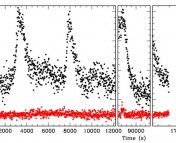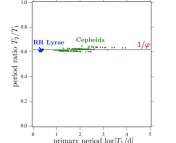Title: Beyond the Kepler/K2 bright limit: variability in the seven brightest members of the Pleiades
Authors: T. R. White, B. J. S. Pope, V. Antoci, P. I. Pápics, C. Aerts, D. R. Gies, K. Gordon, D. Huber, G. H. Schaefer, S. Aigrain, S. Albrecht, T. Barclay, G. Barentsen, P. G. Beck, T. R. Bedding, M. Fredslund Andersen, F. Grundahl, S. B. Howell, M. J. Ireland, S. J. Murphy, M. B. Nielsen, V. Silva Aguirre, P. G. Tuthill
First author’s institution: Stellar Astrophysics Centre, Department of Physics and Astronomy, Aarhus, University, Ny Munkegade 120, DK-8000, Aarhus C, Denmark
Status: Published in MNRAS
Too bright to handle
In astronomy, we can’t control how stars behave, only watch from afar. So in order to get good constraints on stellar properties and build accurate stellar models, we need to study stars using multiple techniques, such as both space- and ground-based photometry, spectroscopy and interferometry.
This is certainly the case for results from NASA’s Kepler exoplanet hunting mission and its continuation K2, which – after failure of one of Kepler’s reaction wheels – observed various fields around the ecliptic. The many exoplanet detections made with Kepler and K2 need to be confirmed using follow-up observations from the ground. Similarly, Kepler’s huge wealth of data used in asteroseismic analysis – the study of stellar pulsations – requires input from ground based spectroscopic surveys.
The catch is that bright stars that make ideal targets for ground-based techniques are too bright for space-based missions, such as Kepler and K2. The Kepler telescope’s CCD cameras were built for detecting faint dips in light that reveal a transiting planet, effectively collecting light in ‘buckets’, with each being represented by a pixel on an image. For very bright stars, the ‘buckets’ reach the limit for how much they can hold, and become saturated. Any extra light will overflow and ‘bleed’ into surrounding pixels in columns above and below the star. Due to limited bandwidth, Kepler could only download so many pixels, making bright stars with their large saturated columns unfeasible targets. If we want to make full use of the stellar laboratories these stars provide, we have to develop a way to obtain their signal in a more reliable, and less costly, manner.
Halo photometry
This was the motivation behind halo photometry, a new technique to obtain high quality data for extremely bright stars observed with K2 around the ecliptic. An international group of astronomers, led by Tim White, developed a method that built upon previous work by Aerts et al. (2017), who found that they could recover a bright star’s signal from light scattered onto nearby pixels. They expand upon this by weighting contributions from individual pixels in a ‘halo’ around the star. By weighting the pixels based on the spacecraft systematics and signal losses present in each pixel, they can simultaneously obtain the signal from the star and perform systematics correction, which are usually done in two separate steps. Doing so is incredibly valuable for K2, where the loss of the reaction wheel caused it to perform periodic rolling motions, affecting the signal.

The Seven Sisters
The authors set their sights on a well-known target to test this new method: the seven brightest stars of the Pleiades star cluster, also known as the Seven Sisters (in order of brightest to faintest: Alcyone, Atlas, Electra, Maia, Merope, Taygeta and Pleione). Their method manages to obtain a precision on par with stars that are unsaturated, and to a level where possible exoplanets could be detected! While they do not find any exoplanets in their data, they do find that light from the seven sisters varies periodically at a rate up to once every two days. For six of the seven these are consistent with a class of star called slowly pulsating B-stars. One sister however, is beating out a slightly different tune.

The curious case of Maia
The variability of one of the Seven Sisters in particular has an interesting history dating back over 60 years: Maia.
Variability was first claimed in Maia by noticing how the spectroscopic lines of the element helium changed in intensity on a 2-hour timescale. As this did not quite match any existing type of variable star at the time, the ‘Maia variables’ class, with periods of 1 to 4 hours, was proposed. However, when further searches for variability in Maia repeatedly found it to be stable (that is to say, not variable), the question became whether Maia was even variable in the first place. And while some stars have since been discovered that vary on a 1 to 4 hour timescale, the existence of Maia variables as a distinct class has become a matter of controversy.
Thanks to the combination of K2’s excellent space-based data, and the new halo photometry technique, the authors find that Maia is undeniably variable. This is a great breakthrough, except… Maia is not a Maia variable! Its newly discovered 10-day period is completely inconsistent with the existing definition of the Maia variable class. In order to investigate the source of the variability, the authors used additional ground-based spectroscopy from the SONG telescope and interferometry from the CHARA Array. They found that the visual variability correlated with changes in intensity of the spectroscopic lines of manganese, an element that the star contains in abundance. This confirmed that the variability seen by K2 is due to luminosity changes caused by a chemical overdensity (or ‘chemical spot’) near Maia’s surface viewed at the equator as it rotates in and out of view.
The future is bright
Using halo photometry, it is now possible to reliably obtain high-quality time series data for extremely bright stars observed with space telescopes, even to a precision where exoplanets and asteroseismic signals can be detected. In fact, at time of writing, this technique has already been applied to study a planet around the bright star Aldebaran and stellar winds on the supergiant rLeo. And over the course of the next two years, the TESS telescope will gather brand new data for hundreds of thousands of nearby stars, including the Seven Sisters. The future is looking bright for the most luminous stars in our night’s sky.




